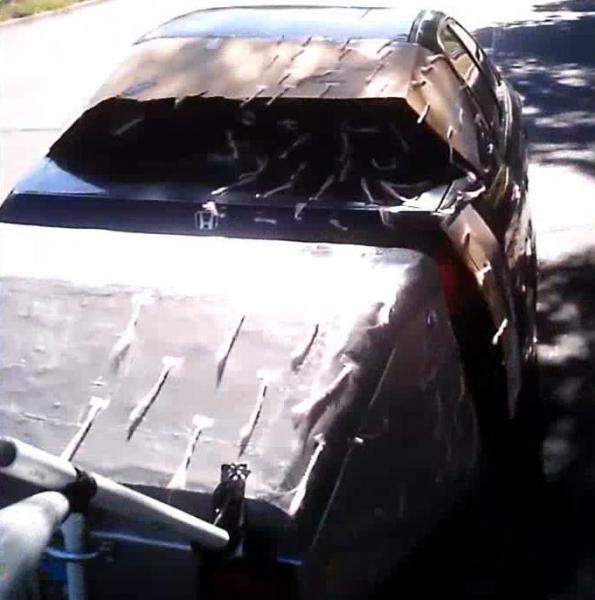Quote:
Originally Posted by California98Civic

Thanks for the vids. I'm also involved in some cardboard aided design in my build thread. I have no special training. I just hang around this forum. And it looks to me like there is a larger than stock recirculation zone on the glass in clip #1 and that that zone grows very significantly in clips 2 and 3 with the kamm. I would think these all indicate down stream turbulence, but then the flow seems attached at the hitch box. Still couldn't that attached flow be just the air getting forced around the box, with turbulent wake above it and downstream of the hitch box?
Can you bring the hitch box closer to the rear bumper and close the gap, especially at the top? I bet their is a sort of bow wave at the front of the hitch box caused by the air rushing down from the roof and in from the sides down into that gap at the tail for the trunk.
EDIT: It occurs to me that if all you end up with is a cargo box that adds no big drag but does not reduce it, either, then you are still ahead of the roof mounted units.]  |
I actually think if the Aero Hitch Box fails to improve drag that I come out behind, since I already had that configuration with cheaper commercial components (rack and bag). But let's not get pessimistic.

My thoughts at this point:
- The excess "stock" turbulence certainly is a mystery.
- Tuft testing works well if the shape you're tufting is supposed to be an airfoil, i.e. where the body surface coincides with the relevant flow fields. I think tufts are intrinsically hard to interpret here because the shape I've got has gaps and so there are important flow fields that we can't see with tufts. A smoke wand would be much better.
- I was dismayed to find the contrast of the tufts on top of the Kamm made them invisible in all of my youtube posts. Here's a still from the raw data. The only time you can see the tufts really well is when the car passes under a tree.

What I wanted to know is whether the flow over the Kamm is smooth; I'm still not sure. It looks like parts of it are smooth, but I think that one weird tuft is real (not stuck on something).
- The turbulence under the Kamm seems to be fed from the side of the car. I think once again we have higher pressure on the side. I'm still scratching my head about this, but it could simply be that the shape is 'astigmatic,' meaning the roofline curves before the side, as opposed to being rotationally symmetric. I also wonder if it has something to do with my grille block.
- One theory is that the Kamm needs to have a lower angle. I might even have to raise the Aero Box lid to make the car's target profile more rotationally symmetric. My competing theory is that it just needs to be a full Kammback, from the roofline to the bumper. And of course for that to work properly it needs rounded edges.
- No evidence of baffling having created an improvement. No evidence of a vertical air flow being a factor in any configuration.
- No evidence of the side detachment garnish creating an improvement. Maybe I need to start the form further forward on the car and make the trailing edge flat like the box side instead of rounded like the car side.
- The rear wheel skirt does help against the turbulence found at the side of the rear bumper, but doesn't affect the side of the box. I've always wondered whether the slick wheel cover and skirt are redundant, now I have my answer.
So there's more work to do.